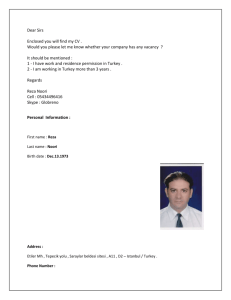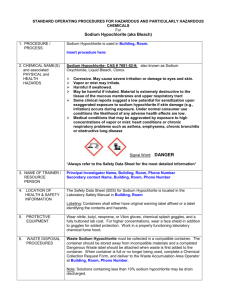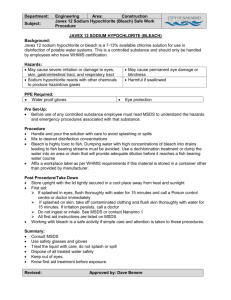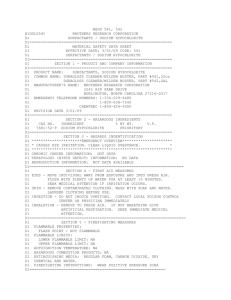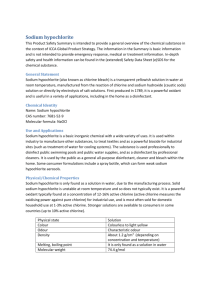the effects of sodium hypochlorite on mesophilic aerobic bacteria
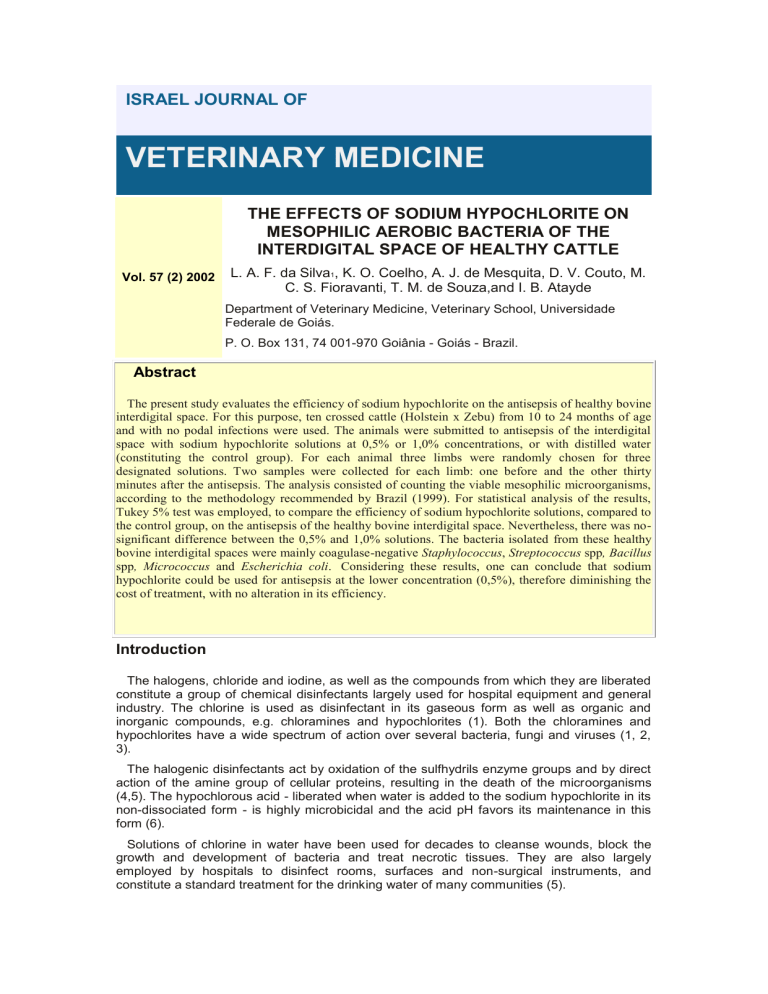
ISRAEL JOURNAL OF
VETERINARY MEDICINE
THE EFFECTS OF SODIUM HYPOCHLORITE ON
MESOPHILIC AEROBIC BACTERIA OF THE
INTERDIGITAL SPACE OF HEALTHY CATTLE
Vol. 57 (2) 2002
L. A. F. da Silva
1
, K. O. Coelho, A. J. de Mesquita, D. V. Couto, M.
C. S. Fioravanti, T. M. de Souza,and I. B. Atayde
Department of Veterinary Medicine, Veterinary School, Universidade
Federale de Goiás.
P. O. Box 131, 74 001970 Goiânia - Goiás - Brazil.
Abstract
The present study evaluates the efficiency of sodium hypochlorite on the antisepsis of healthy bovine interdigital space. For this purpose, ten crossed cattle (Holstein x Zebu) from 10 to 24 months of age and with no podal infections were used. The animals were submitted to antisepsis of the interdigital space with sodium hypochlorite solutions at 0,5% or 1,0% concentrations, or with distilled water
(constituting the control group). For each animal three limbs were randomly chosen for three designated solutions. Two samples were collected for each limb: one before and the other thirty minutes after the antisepsis. The analysis consisted of counting the viable mesophilic microorganisms, according to the methodology recommended by Brazil (1999). For statistical analysis of the results,
Tukey 5% test was employed, to compare the efficiency of sodium hypochlorite solutions, compared to the control group, on the antisepsis of the healthy bovine interdigital space. Nevertheless, there was nosignificant difference between the 0,5% and 1,0% solutions. The bacteria isolated from these healthy bovine interdigital spaces were mainly coagulase-negative Staphylococcus , Streptococcus spp , Bacillus spp , Micrococcus and Escherichia coli . Considering these results, one can conclude that sodium hypochlorite could be used for antisepsis at the lower concentration (0,5%), therefore diminishing the cost of treatment, with no alteration in its efficiency.
Introduction
The halogens, chloride and iodine, as well as the compounds from which they are liberated constitute a group of chemical disinfectants largely used for hospital equipment and general industry. The chlorine is used as disinfectant in its gaseous form as well as organic and inorganic compounds, e.g. chloramines and hypochlorites (1). Both the chloramines and hypochlorites have a wide spectrum of action over several bacteria, fungi and viruses (1, 2,
3).
The halogenic disinfectants act by oxidation of the sulfhydrils enzyme groups and by direct action of the amine group of cellular proteins, resulting in the death of the microorganisms
(4,5). The hypochlorous acid - liberated when water is added to the sodium hypochlorite in its non-dissociated form - is highly microbicidal and the acid pH favors its maintenance in this form (6).
Solutions of chlorine in water have been used for decades to cleanse wounds, block the growth and development of bacteria and treat necrotic tissues. They are also largely employed by hospitals to disinfect rooms, surfaces and non-surgical instruments, and constitute a standard treatment for the drinking water of many communities (5).
In veterinary medicine, sodium hypochlorite is used for antisepsis of mammary glands, and for “pre-dipping” and “post-dipping” of milking equipment for disinfecting, at concentrations of
2% to 4% of active chlorine (7, 8). Sodium hypochlorite has also been indicated for use in footbaths, as an auxiliary method for treating and preventing pedal infections of cattle.
Sodium hypochlorite has advantages such as low cost, low toxicity, fast sanitary action and effectiveness over viruses and spore bacteria. As disadvantages, it is pointed out irritation of animal and manipulator’s tissues, low stability for stocking and difficulties in handling due to the requirement of active chlorine on the utilization. The presence of organic material can also interfere with its action (4, 9).
Despite the lack of information on the stability and bacterial effects of the product, its use as a disinfectant solution in footbaths is prevalent. It has been utilized routinely on many rural properties and on post operative of pedal infections of cattle.
The following study was designed to evaluate the efficiency of sodium hypochlorite on the antisepsis of healthy bovine interdigital space.
Materials and Methods
Ten bovine crosses Holstein x Zebu, males and females, ten to 24 months old, belonging to the herd of the School of Veterinary Medicine of Universidade Federal de Goiás, were used.
After feed and water fasting of 12 hours, each animal was restrained in lateral right-sided decubitus, having their limbs immobilized by ropes to make the clinical examination easier
(10). Next, it was individually drawn a limb to each one of the solutions employed for antisepsis of the interdigital space. The bovines submitted to antisepsis with the 0,5% sodium hypochlorite solution, constituted group I, and those submitted to antisepsis with the 1,0% sodium hypochlorite solution
1
constituted group II. For the animals of the control group (III) distilled water was used.
Each limb was cleaned to remove excess organic material. Then, a sample was taken from the interdigital space with a sterile swab, and was immediately placed in a tube containing 9 ml of peptone water at a concentration of 0,1%
2
. Immediately after, each interdigital space was submitted to antisepsis with the sodium hypochlorite solutions
1
or distilled water, according to which group it belonged.
Prior to the preparation of the solutions, the active chlorine in the commercial sodium hypochlorite solution was determined by atomic absorption spectrophotometry (11). First the sodium concentration value was determined, and then, by subtraction, the concentration of
10% active chlorine. Based on such concentration, the dilutions were made as 0,5% and
1,0%. After preparing the solutions the pH was measured by a digital potentiometer
3
.
The solutions were applied with sterile gauze pads on all the extension of the interdigital space, 30 minutes were allowed for drying and a new sample was taken, following the same procedure.
The samples were sent to the laboratory under refrigeration (4
0
C to 10
0
C), and were immediately processed. For preparation of the dilutions, the tube containing the swab in peptone water was considered to constitute the 10
0
dilution, and after this, serial tenfold dilutions were made in peptone water
2
from 0,1% until 10
-5
(12).
The microbiological analysis followed the recommendations of Lanara (12), by pipetting 1 ml of the dilutions and placing them on sterilized and identified Petri dishes. Fifteen ml of standard count agar
4
were added to each dish. After homogenization, the Petri dishes were incubated at 35
0
C for 48 hours, after which a colony-forming-unit count was performed.
Macroscopic analysis of the bacterial colonies was first made on the dishes with bacterial growth, and the morphologically different colonies were repeated on Tryptic Soy agar (TSA)
5
.
The following procedure was adopted for isolation and identification of the bacterial population
(13).
In order to compare the results of the bacterial analysis of the samples, an adaptation of the methodology proposed by (9) was adopted, where the result expressed as 10
3
was considered as a low bacterial count, as medium between 10
3
to 10
4
, and high above 10
5
.
The obtained results were statistically analyzed using Tukey 5% test (14).
Results
6
7
8
9
10
1
2
3
4
5
The results of this study are presented in tables 1 and 2.
During the experiment, an irritation in the interdigital space of three animals submitted to antisepsis with sodium hipochlorite 1,0% was observed, revealed by the presence of a minor local vascular congestion. This did not occurr in the cattle treated with sodium hypochlorite at
0,5% concentration.
The microorganisms isolated from the interdigital space of healthy bovines were Gramnegative and Gram- positive bacteria, represented by Escherichia coli, Bacillus spp, coagulase negative Staphylococcus , Micrococcus and Streptococcus spp.
The obtained pH values were as follows: pH
1
-9,00; pH
2
-11,01; pH
3
- 11,06; for the distilled water, NaClO at 0,5% and 1,0% concentrations, respectively.
Table 1 Viable mesophilic aerobic bacteria found in healthy bovine interdigital spaces, before and after cleansing with distilled water or antisepsis with sodium hypochlorite solutions at
0,5% and 1,0% concentrations.
ANIMAL CONTROL
Distilled Water before after
2,0 x 10
6*
9,0 x 10
4
6,3 x 10
4
7,3 x 10
3
5,8 x 10
3
4,6 x 10
4
3,0 x 10
3
5,2 x 10
2
7,2 x 10
3
1,2 x 10
3
9,2 x 10
3
1,9 x 10
3
6,0 x 10
3
5,2 x 10
3
4,7 x 10
3
2,8 x 10
3
2,6 x 10
4
2,6 x 10
4
1,9 x 10
5
7,1 x 10
4 before
7,9 x 10
1,1 x 10
1,4 x 10
1,6 x 10
6
4
1,0 x 10
5
1,9 x 10
4
5,5 x 10
4
1,0 x 10
1
2,3 x 10
3
1,2 x 10
4
5
5
SODIUM HYPOCHLORITE
0,5%
after
1,7 x 10
2 before
3,2 x 10
5
1,0%
after
1,0 x 10
2
<1,0 x 10
1
est.
<1,0 x 10
1
est.
<1,0 x 10
1
est.
4,3 x 10
5
1,0 x 10
6
3,0 x 10
3
6,0 x 10
2
1.4 x 10
3
1,0 x 10
2
3,2 x 10
2
<1,0 x 10
1
est.
<1,0 x 10
1
est.
<1,0 x 10
1
est.
<1,0 x 10
1
est.
<1,0 x 10
1
est.
5,1 x 10
4,5 x 10
9,6 x 10
1,5 x 10
5,4 x 10
1,8 x 10
5
4
4
3
4
5
<1,0 x 10
2,7 x 10
<1,0 x 10
<1,0 x 10
<1,0 x 10
<1,0 x 10
1
1
1
1
1
4
est.
est.
est.
est.
est.
Mean 4,9 x 10
4
4,7 x 10
4
2,5 x 10
4
1,4 x 10
1
3,9 x 10
5
Statistics 44.306
038.9812
43.7493
7.1516
49.1226
results expressed on UFC/ area of the interdigi tal space.
1-Sodium hipochlorite - Casa Forte - Goiânia/GO
2Peptona de Caseína - Merck - Rio de Janeiro/RJ.
3-Digital pH meter - Nova Técnica - São Paulo/SP
4-Standard Count Agar - Merck- Rio de Janeiro
5-Merck Tryptic Soy Agar - Rio de Janeiro
Table 2 Means of the statistical analysis, of the sodium hypochlorite solutions at 0,5% and
1,0% and distilled water.
Solutions Means
Sodium Hypochlorite 0,5% 0,7152 a*
Sodium Hypochlorite 1,0% 1,5880 a*
Distilled Water 3,8981 b
* Do not differ between each other.
Discussion
Sodium hypochlorite used in the solutions was analyzed to verify the active chlorine concentrations, for the values given on the label may not correspond to the real concentration of active chlorine in the product. Of products sold in Goiânia, concentrations of 0,12% and
0,59% of active chlorine were found, for declared label values of 7% and 10%, respectively
(15). Based on such findings, it was decided to determine the active chlorine concentrations to ensure the disinfecting power of the solutions.
The concentrations of 0,5% and 1,0%, used on the experiment were stipulated considering the relation between time of contact / concentration of active chlorine (1, 3). The option for lower concentration solutions was a trial to avoid potential irritation of the interdigital space.
For antisepsis of mammary glands, solutions of 2% and 4% concentrations are regularly employed, due to the minimum time of contact required (7, 8). On the other hand, it is recommended to allow about three minutes of permanence on the footbath, therefore increasing the time of exposure to the disinfectant solution (16). Analyzing both procedures, it was decided to employ less concentrated solutions, due to the period of exposure to the product, which on average was 20 minutes.
The solutions were prepared on the same day and stored in dark flasks until the time of antisepsis, because chlorine solutions once exposed to the light, have the hypochlorite molecules broken into chlorides (Cl)†and oxygen (O
2
), thus†inactivating the product (5, 17).
The pH of the solutions was measured because the alkaline ir acid pH of the solutions could be directly involved in the inflammatory process of particular internal or external structures of distal extremities of bovines limbs (18).
1,9 x 10
2
15.8801
Also, the pH of the solutions is directly related to the bactericidal effectiveness of the chemical products employed as disinfectants (3, 19).
The pH of the solutions was kept alkaline, above 11. This parameter suggests that the solution could be used on footbaths, especially for preventing infection by Fusobacterium necrophorum , which presents low resistance to solutions of alkaline pH (20). However, it should be pointed out that previous researches reveal unsatisfactory results when using products of alkaline pH, such as calcium oxide (“lime”) (16). It is also considered that sodium hypochlorite, when used on a pH close to 7,0 has its microbicide activity increased (21), therefore, despite the higher efficiency of the alkaline solution over the Fusobacterium necrophorum, for other pathogens the bactericidal effect does not occur appropriately.
The occurrence of irritation of the interdigital space, revealed by the presence of a slight local vascular congestion, was shown by several authors, who point that sodium hypochlorite irritates animal tissues (3, 4).
The results obtained are considered similar to those of other workers (7, 8), although they have worked with 4% concentrations of chlorine on the antisepsis of mammary glands and prevention of bovine mastitis.
The results obtained indicate that it is possible to employ hypochlorite solutions on the antisepsis of bovine interdigital space. One author mentions that the criteria and standards for the use of solutions in footbaths have not yet been clearly determined, especially referring to the concentrations of the solutions used and its efficiency (16).
During the present study the correct use of sodium hypochlorite was raised. Criteria were established to allow the maximum positive effects of antisepsis, such as: conditions of storage
(bottling) of the solution, utilization of the product, determination of the concentration, pH estimation and removal of organic material in the interdigital space. Several authors recommend these steps (2, 3, 22).
The bacterial population represented by Escherichia coli, Bacillus spp, coagulase negative
Staphylococcus , Micrococcus and Streptococcus spp, present in samples from healthy bovine interdigital spaces resembles that of soil, corral and the environment (23, 24). It is also considered that microorganisms such as Streptococcus spp and coagulase negative
Staphylococcus could favor the development of limb infections, when the animals bear stress and inadequate management conditions (25).
LINKS TO OTHER ARTICLES IN THIS ISSUE
References
1. Guerreiro, M. G., Oliveira, S. J., Saraiva, D., Wiest, J. M.; Lieberknecht, F., Poester, F. P.,
Dias, J. C. A.; Fernandes, J. C. T. , Lan Geloh, A. and Baptista, P. J. H. P.: Bacteriologia
Especial de Interesse em Saúde Animal e Saúde Pública, Sulina, Porto Alegre, 1984.
2. Carter, G. R., Clavs, G. W. and Rikinish, Y.: Fundamentos de Bacteriologia e Microbiologia
Veterinária, Roca, São Paulo, 1998.
3. Booth, H.N. and McDonald, E. L.: Farmacologia e Terapêutica em Veterinária, Guanabara
Koogan S.A, Rio de Janeiro, 1992.
4. Fonseca, L. F. L. and Santos. M. V.: Qualidade do Leite e Controle de Mastite, Lemos editora, São Paulo, 2000.
5. Wistreich, A. G. and Lechtman, D. M.: Microbiologia das doenças humanas, Guanabara
Koogan, Rio de Janeiro, 1980.
6. Pankey, J. W., Philpot, W. N., Boddie, R. L. and Watts, J. L.: Evaluation of nine teatdips under experimental challenge to Staphylococcus aureus and Streptococcus agalactiae. J. Dairy
Sci .
, 66: 161 - 7, 1983.
7. Ribeiro, A. R.: Influência da antissepsia pós- ordenha na ocorrência de mastite bovina.
Dissertação Mestrado.
USP, São Paulo, 1996. 124 pp.
8. Drechsler, P.A., Wildman, E. E. and Pankey, J.E.: Evaluation of a chlorinedioxide teat dip under experimental and natural exposure condition. J. Dairy Sci., 73:2121-8,1990.
9. Andrade, N. J. an d Macêdo, J. A. B.: Higienização na Industria de Alimentos. Varela, São
Paulo, 1996.
10. Dirksen, G.: Sist. Locomotor. In: exame clínico dos bovinos. Guanabara Koogan, Rio de
Janeiro, pp 36-55, 1993.
11. Gonçalves, J. R.: Determinação de Metais Pesados em Leite Fluido Integral de Bovinos no
Estado de Goiás. Dissertação (Mestrado). Escola de Veterinária, U.F.G., Goiânia, p. 80 1999.
12 Lanara: Métodos Analíticos Oficiais para Controle de Produtos de Origem Animal e seus
Ingredientes. Ministério da Agricultura, Brasilia, 1999.
13. Oliveira, S. J.: Microbiologia Veterinária. Ed. da ULBRA, Canoas, 1995.
14. Centeno, A. J.: Curso de Estatística Aplicada a Biologia. Goiânia, Cegraf, 1990.
15. Nicolau, E. S.: Avaliação das condições higiênico-sanitárias de indústrias de laticínios produtoras de queijo tipo mussarela na região de Goiânia - GO, com ênfase para o
Staphylococcus aureus, tese Doutorado. UNICAMP, Campinas, p. 160, 2000.
16. Cunha, P. H. J.: Avaliação Físico-Química, Microbiológica e Eficácia Terapêutica das
Soluções Desinfetantes. Dissertação (Mestrado), EV, UFG, Goiânia, p. 131, 2000.
17 Dychidala, G. R.: Chlorine and Chlorine Compounds. In: Block, S. S. (Ed.): Disinfection,
Sterilization and preservation. Lea & Febiger, London, pp. 131-151, 1991.
18. Reed, G. A. and Alley, D. U.: Efficacy of a Novel Copper - Based Footbath Preparation for the
Treatment of Ovine During the Spread Period. Aust. Vet. J. 5, 1996.
19. Joklik, W. K., Willet, H. P. and Ramos, D. B.: Microbiologia. Panamericana, Buenos Aires,
1994.
20. Blood, D. C. and Radostitis. O. M.: Clínica Veterinária, Guanabara Koogan S.A, Rio de
Janeiro, 2000.
21. Eiroa et al: Colt. Inst. Tecnol. Alimentos. 26(20): 199-207, 1996.
22. Andrade, M. A., Mesquita, A. J., Silva, L. A. F. and Paulo, N. M.: Freqüência de Bactérias isoladas no ambiente, em feridas cirúrgicas, em médicos veterinários, enfermeiros e auxiliares de enfermagem. IInfecção em hospital veterinário, Anais de Escola de Veterinária e Agronomia UFG 1:1-8, 1991.
23. Ruiz, R. L.: Microbiol ogia Zootécnica. Roca, São Paulo, 1992.
24. Fernandes, D. O: Uso Terapêutico do Cloridrato de Oxitetraciclina Contra a Podridão de
Cascos dos Bovinos: Resultados no Brasil. Hora Veterinária , ( 99) 1997.
1.

